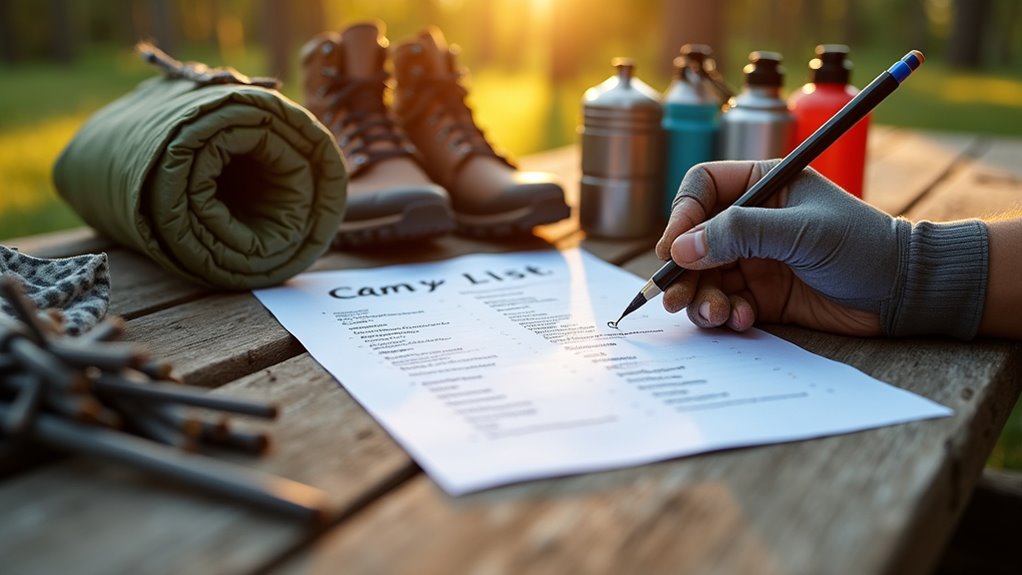Physical Address
304 North Cardinal St.
Dorchester Center, MA 02124
Physical Address
304 North Cardinal St.
Dorchester Center, MA 02124

Don't let post-camping mistakes ruin your gear or future adventures—this essential departure checklist prevents costly oversights that experienced campers never ignore.
When you’re packing up camp after a great outdoor adventure, it’s easy to feel rushed and forget vital steps that could impact both your gear and the environment. You might think throwing everything in the car and heading home is straightforward, but experienced campers know there’s a specific sequence that prevents costly mistakes and guarantees you’re welcome back. Miss even one item on this departure checklist, and you could face consequences that’ll haunt your next trip.

How often have you arrived at your campsite only to realize you’ve forgotten something essential? While most camping guides focus on what to pack before you leave, they rarely address the equally important task of wrapping up your trip properly. Your post-camping checklist ensures you leave no trace, protect your gear, and maintain good relationships with fellow campers and campground staff.
Start by thoroughly cleaning your campsite. Pack all trash, even tiny pieces of paper or food scraps that might attract wildlife. Check fire rings for any remaining embers and douse them completely with water, stirring the ashes until they’re cold to the touch. Scatter the cold ashes away from the campsite. Don’t forget to look under picnic tables, around tent areas, and near water sources where debris often gets overlooked.
Pack every scrap of trash, extinguish fires completely, and check overlooked spots under tables and near water sources.
Inspect your tent and sleeping area carefully. Shake out your tent to remove dirt, leaves, and potential hitchhiking insects before packing it away. Check that all tent stakes are accounted for – they’re easily forgotten and expensive to replace. Roll sleeping bags loosely if they’re damp, then air them out properly once you’re home to prevent mold and odors.
Walk the perimeter of your entire campsite, scanning for forgotten items. Camping chairs, camp tools, and small personal items frequently get left behind. Check bathroom areas, hiking trails you used, and any spots where you might’ve set something down temporarily. If you borrowed or rented equipment from the campground, return it in the same condition you received it.
Before departing, verify your vehicle is properly packed and secure. Ensure coolers are positioned to prevent sliding, and tie down any external gear. Check that your campfire is completely extinguished one final time – this can’t be overstated. Double-check your campsite reservation details to confirm you’re not overstaying your allotted time.
Take photos of your clean campsite before leaving. This serves as documentation that you left the area in good condition and helps you remember the site’s layout for future visits. If you noticed any maintenance issues like broken picnic tables or damaged facilities, report them to campground staff.
Finally, do a mental inventory of your trip’s highlights and any lessons learned. Note what worked well and what you’d do differently next time. This reflection helps improve future camping experiences and ensures you’re building valuable outdoor skills. For those looking to combine outdoor adventures with health goals, weight loss camps offer structured programs that can transform how you approach both fitness and nature activities.
Following this systematic approach protects natural spaces, preserves your equipment, and demonstrates respect for the camping community. Your diligence today makes these beautiful outdoor spaces available for everyone’s future enjoyment.
You might think this checklist’s overkill, but trust me—skipping these steps will bite you later. There’s nothing worse than discovering missing gear at home or facing hefty fines for leaving a messy campsite. Take those extra fifteen minutes to do it right. Your future self will thank you when you’re unpacking clean, organized gear instead of muddy chaos. Plus, you’ll protect these wild places for everyone who comes after you.